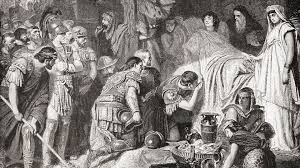Introduction
Imagine a world where nearly half the population disappears within a few years. Cities empty, farms are abandoned, and entire villages vanish. This was the reality of the Black Death, one of the deadliest pandemics in human history. Between 1347 and 1351, the plague swept through Europe, killing an estimated 30-50% of the population. But beyond the immediate horror and loss, the Black Death left a profound and lasting impact on Europe’s economy, shaping the future in unexpected ways.
From labor shortages to wage increases, agrarian shifts, and the decline of feudalism, the economic repercussions of the plague were vast. Let’s dive into the long-term economic transformations triggered by this catastrophic event.
The Immediate Economic Aftermath
A Devastated Workforce
One of the most obvious consequences of the Black Death was the staggering loss of life. With millions dead, the workforce shrank dramatically. Fields lay fallow, workshops fell silent, and construction projects halted. The demand for laborers far outstripped supply, giving surviving workers newfound bargaining power.
Inflation and Price Fluctuations
With fewer people producing goods, the supply of essential products plummeted. This scarcity led to inflation, with prices of food and other necessities rising sharply. At the same time, luxury goods saw a decline in demand, causing prices to drop for non-essential items.
The Rise of Wages and the End of Serfdom
Labor Becomes More Valuable
For the first time in centuries, peasants and artisans had leverage. Landowners and employers were desperate for workers, leading to higher wages and better working conditions. This shift undermined the feudal system, where peasants were bound to their lords with little autonomy.
Peasant Revolts and Social Mobility
In response to rising wages, many landowners attempted to enforce pre-plague wages through laws such as England’s Statute of Laborers (1351). However, this only fueled resentment, culminating in peasant revolts, such as the English Peasants’ Revolt of 1381. These uprisings marked the beginning of the end of serfdom in Western Europe.
The Shift in Agriculture and Land Use
From Grain to Livestock
With fewer people to work the land, large tracts of farmland were abandoned. Many landlords switched from labor-intensive crop farming to sheep grazing, which required fewer workers but remained profitable due to rising demand for wool.
Increased Efficiency and Innovation
The decline in population also encouraged landowners to adopt more efficient farming techniques, crop rotation, and new tools, laying the groundwork for agricultural advancements that would later fuel the Renaissance and beyond.
Urban Growth and the Rise of the Middle Class
Cities Rebound with New Opportunities
Despite the initial devastation, many cities recovered by attracting migrants seeking work. The demand for skilled labor in urban areas surged, leading to the growth of the middle class.
Strengthening of Guilds
With fewer artisans and craftsmen, guilds gained influence and were able to negotiate better wages and working conditions. This helped standardize production and set the stage for the later expansion of European trade and commerce.
The Decline of Feudalism and the Rise of Capitalism
Lords Lose Power, Kings Gain Strength
As serfdom crumbled, feudal lords struggled to maintain their traditional grip on power. Kings and centralized governments began to fill the power vacuum, laying the foundation for modern nation-states.
Early Capitalist Practices Emerge
With laborers demanding wages and mobility increasing, markets became more dynamic. The Black Death accelerated the transition from a rigid feudal economy to a more flexible, cash-based economy, paving the way for capitalism.
Impact on Trade and Global Markets
Disrupted Trade Routes
The plague disrupted major trade networks, including the Silk Road, slowing down commerce for decades. However, once trade resumed, demand for luxury goods like silk and spices soared, boosting economic ties between Europe and Asia.
Maritime Trade Takes Center Stage
With land routes weakened, maritime trade flourished. Cities like Venice, Genoa, and Lisbon rose to prominence, eventually playing key roles in the Age of Exploration.
The Church, Wealth, and Economic Change
Declining Clerical Influence
The Church, once Europe’s dominant force, lost credibility as prayers and religious rituals failed to stop the plague. This weakened the Church’s economic and political control, contributing to later movements like the Protestant Reformation.
Redistribution of Wealth
As wealthy families died out, their land and possessions were redistributed. Many survivors found themselves unexpectedly wealthier, leading to increased consumer spending and investment in education, art, and science.
The Psychological and Cultural Shift
A New Attitude Toward Life and Wealth
Survivors of the Black Death adopted a more individualistic outlook. With death so prevalent, people sought to enjoy life, leading to higher spending on art, literature, and entertainment key drivers of the Renaissance.
Education and Innovation
The labor shortages highlighted the importance of knowledge and skills, fueling interest in education, universities, and technological advancements, which contributed to later economic revolutions.
Conclusion
The Black Death was a catastrophe of unimaginable scale, but it also acted as a catalyst for economic transformation. From higher wages and improved working conditions to the decline of feudalism and the rise of capitalism, its impact reshaped Europe’s economic landscape in profound ways.
Without the plague, the Renaissance, the Age of Exploration, and the Industrial Revolution might have unfolded very differently. In many ways, this dark chapter in history laid the foundation for the modern economic world.
FAQs
1. How did the Black Death improve workers’ wages?
With fewer workers available, labor became more valuable. Surviving peasants and artisans were able to demand higher wages and better conditions, leading to a decline in feudalism.
2. Did the Black Death lead to the end of feudalism?
Yes, the labor shortages and increased mobility of workers weakened the feudal system, as landowners struggled to enforce old obligations, leading to its gradual decline.
3. How did agriculture change after the Black Death?
Many landowners switched from crop farming to livestock (especially sheep) since it required fewer workers, leading to changes in European land use and trade.
4. What was the role of the Black Death in the rise of capitalism?
The shift toward wage-based labor, the decline of serfdom, and the growth of urban centers contributed to early capitalist practices, moving Europe away from a feudal economy.
5. Did the Black Death have any positive effects?
Despite its devastation, the Black Death led to higher wages, better working conditions, increased social mobility, advancements in farming, and the weakening of the rigid feudal order, all of which helped shape modern economies.


